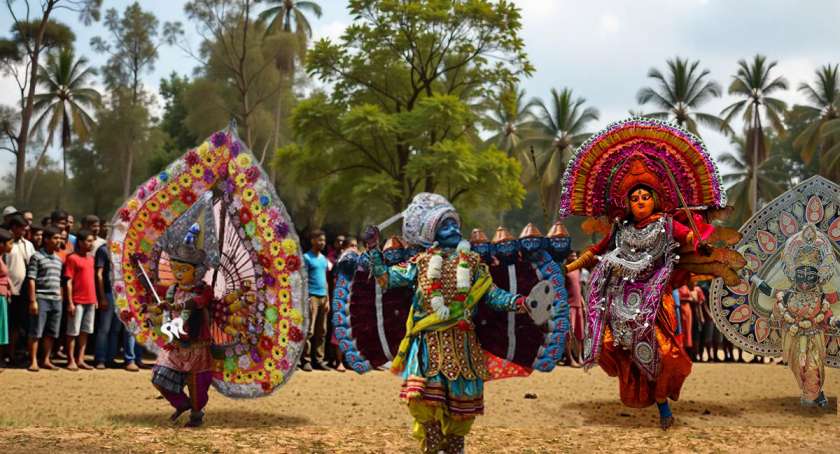Medha Nacha: Dancing with the Divine
Medha Nacha, the traditional mask dance of Odisha, is a captivating folk performance deeply rooted in the region’s cultural and religious heritage. Performers showcase this vibrant dance during Durga Puja and temple festivals, donning elaborate masks and enacting mythological tales. Combining energetic movements, rhythmic beats, and intricate storytelling, Medha Nacha serves as both entertainment and a spiritual offering. Originating in coastal Odisha, this centuries-old tradition enthralls audiences with its dramatic expressions and artistic brilliance.
Origins and Historical Significance
The word “Medha” means mask, and “Nacha” refers to dance, making Medha Nacha a performance where dancers don elaborate masks and enact mythological stories. People believe this folk tradition originated in coastal Odisha, particularly in Puri, Cuttack, and Kendrapara districts, where they perform it as a tribute to the gods and goddesses.
Historically, Medha Nacha evolved as an integral part of religious processions, especially during the immersion of idols in Durga Puja and other temple festivities. The dance form is often associated with Jatra (folk theatre) and Pala (traditional storytelling performances), which are deeply rooted in Odisha’s cultural landscape.
Medha Nacha was performed in ancient times to invoke divine blessings, ward off evil spirits, and entertain devotees. Odia literature and temple inscriptions mention the tradition of mask dancing, proving its long-standing presence in the state’s artistic heritage.
The Art of Mask Making
One of Medha Nacha’s most striking features is the elaborate masks the performers wear. Artists traditionally make these masks from papier-mâché, wood, or clay and paint them in vibrant colors to depict gods, goddesses, demons, and mythological characters.
Artisans from Puri, Raghurajpur, and Cuttack are known for their exceptional artistry in creating these Medhas. The masks are often adorned with gold foils, mirror work, and complex carvings, making them a visual spectacle. The larger-than-life masks can be heavy, requiring the dancers to balance them while performing energetic movements.
Making these masks involves multiple stages, including sculpting, drying, painting, and decorating. Skilled artisans ensure that each mask captures the essence of the character it represents, bringing the performance to life.
Elements of the Performance and Dance Style
Dancers perform Medha Nacha in open spaces, temples, or during processions. Dancers in bright costumes and towering masks move rhythmically to the beats of drums, cymbals, and conch shells.
- Music and Instruments
Traditional Odia musicians accompany the dance with instruments like the Dhol (drum), Jhanja (cymbals), and Mridangam. The energetic beats create a thrilling atmosphere that captivates the audience. The rhythmic drumming and chants heighten the intensity of the performance, making it a spiritual and visual delight.
- Dance Movements
Despite wearing heavy masks, the dancers display vigorous and synchronized movements, often imitating divine or mythological characters. Their steps include spins, jumps, and dramatic gestures, making it an engaging performance.
To add theatrical elements, performers sometimes mimic the expressions of their characters through exaggerated body language. The interaction between dancers and the audience is another unique aspect, making the performance an immersive experience.
- Storytelling Through Dance
Medha Nacha is not just about dance; it is also a narrative art form. Performers enact stories from Hindu mythology, such as Ramayana, Mahabharata, and Puranas episodes. These stories highlight the victory of good over evil, spreading spiritual and moral messages.
Performers commonly depict characters like Lord Rama, Hanuman, Durga, and Kali, showcasing their distinct movements and gestures. Medha Nacha’s vibrant storytelling makes it an essential medium for preserving and promoting Odia folklore.
The Role of Medha Nacha in Festivals
Medha Nacha, a traditional mask dance of Odisha, is vital to various festivals. It blends religious devotion with vibrant cultural expression.
- Durga Puja Celebrations: During Durga Puja, Medha Nacha performers enact scenes from Hindu epics, showcasing the battle between Goddess Durga and the demon Mahishasura. The dance brings alive the spirit of devotion and celebration.
- Rath Yatra in Puri: In the famous Rath Yatra of Puri, Medha Nacha is performed in the procession of Lord Jagannath, Balabhadra, and Subhadra. Dancers move energetically to the rhythmic beats, creating an electrifying atmosphere.
- Local Village Festivals: Many rural festivals feature Medha Nacha as a primary attraction, drawing crowds from surrounding areas. The dance is both entertainment and a means of preserving cultural heritage.
Regional Variations of Medha Nacha
Different regions of Odisha have their versions of Medha Nacha, each adding its distinct flavor to the dance:
- Puri and Cuttack: Performers use gigantic masks to deliver grand performances during Durga Puja.
- Kendrapara: Features more traditional and rustic styles, focusing on local folklore and deities.
- Balasore and Bhadrak: Performances are often combined with Chhau dance elements, making them more dramatic and acrobatic.
These regional variations ensure that Medha Nacha remains diverse and continues to evolve while maintaining its core traditional elements.
Conclusion
Medha Nacha is more than just a dance; it embodies Odisha’s cultural identity, blending spirituality, art, and history into a captivating performance. From the grandeur of its masks to the rhythmic drumbeats and dramatic storytelling, it remains a vibrant part of Odisha’s artistic heritage. Medha Nacha will continue to captivate audiences for generations as preservation efforts grow. As evidence of Odisha’s creative brilliance and deep-rooted devotion, supporting this unique dance form ensures its survival in the modern era while honoring its traditional essence and rich mythology.


